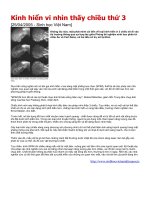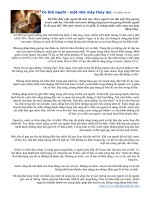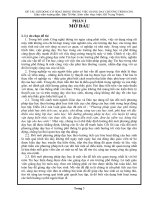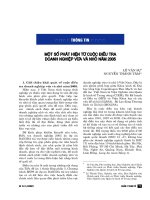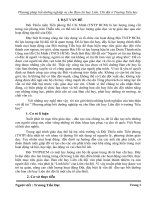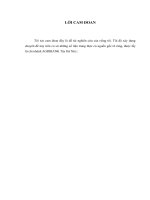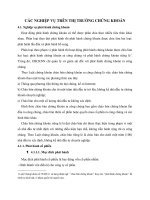Sổ tay nghiệp vụ 7
Bạn đang xem bản rút gọn của tài liệu. Xem và tải ngay bản đầy đủ của tài liệu tại đây (3.4 MB, 91 trang )
Sinh vật đơn bào 'bắt cóc' thực vật - 16/10/2005 0h:9
Các nhà khoa học Nhật Bản đã quan sát thấy một sinh vật đơn bào (cơ thể chỉ có 1 tế bào duy nhất)
đang nuốt chửng và hợp nhất với một thân thực vật còn nhỏ hơn nó để làm nguồn năng lượng dự trữ
sống.
Theo nhóm nghiên cứu, sinh vật này dường như đang trong quá trình endosymbiosis - quá trình mà ở đó
một sinh vật hợp nhất với sinh vật khác, tạo ra dạng sống mới. Họ tin rằng đây chính là con đường tiến hoá
của nhiều loài động và thực vật hiện đại ngày nay.
Phát hiện cũng củng cố thêm giả thuyết được nói tới lâu nay rằng lục lạp - bộ phận nằm bên trong tế bào
thực vật có vai trò sản xuất năng lượng từ ánh sáng mặt trời - thực tế cũng là các sinh vật độc lập, nhưng bị
đã "bắt cóc" theo cách tương tự.
Cũng như vậy, nhóm nghiên cứu gồm Noriko Okamoto và Isao Inouye (Đại học Tsukuba) tin rằng các hợp
phần khác của tế bào - viên gạch tạo nên tất cả các động vật ngày nay - đều có nguồn gốc từ những vi
khuẩn bị "nhốt".
Sinh vật mới, được mệnh danh Hatena (hay Bí ẩn), là một con trùng roi, di chuyển cơ thể bằng cách đẩy cái
đuôi dài của mình. Chúng có những điểm tương đồng cả với thực vật và động vật, nhưng trong một pha
phát triển của cơ thể, chúng lại tương tự như một kẻ ăn thịt. Ở một giai đoạn khác, Hatena chứa một thân
tảo màu xanh, có khả năng quang hợp bên trong cơ thể. Trong giai đoạn này, nó phân chia thành hai tế bào
con - một xanh lục và một không màu. Tế bào con không màu phát triển một công cụ kiếm ăn, và cuối cùng
sẽ nuốt chửng một tế bào tảo xanh khác.
Tế bào tảo xanh, còn được gọi là vật cộng sinh, thuộc về nhóm tảo khá nổi tiếng Nephroselmis, rất phổ biến
trong tự nhiên. Nó cũng có một cái roi, nhưng đánh mất roi đó khi bị tế bào không màu nuốt. Đồng thời, vỏ
ngoài của nó cũng bị tiêu biến, chỉ giữ nguyên phần nhân và các thành phần tế bào khác như lục lạp, ty thể.
Phần màu xanh sau đó phình ra và cung cấp dưỡng chất cho kẻ ăn thịt, lúc này đã thoái hoá bộ máy kiếm ăn
phức tạp của nó.
Các nhà nghiên cứu đã thu thập một vài tế bào con ăn thịt vẫn còn trong suốt, và nuôi chúng bằng một
giống tảo khác, họ hàng với tảo Nephroselmis. "Mặc dù con mồi bị nuốt chửng và không bị tiêu hoá, nó
cũng không trải qua sự biến đổi như đã nói ở trên, chứng tỏ sự tương tác chỉ được biệt hoá chỉ với một
giống nào đó mà thôi".
Giờ đây, nhóm nghiên cứu sẽ tìm hiểu liệu hai loài này có trao đổi gene với nhau - bước được xem là quyết
định trong sự tiến hoá của các loài tảo và thực vật bậc cao.
Ở bên trái, sinh vật "Hatena" sở
hữu một thân tảo lục như một vật
cộng sinh, với một cái đuôi dính
ra ngoài màng tẼ/font>
ahoc\sinh vat hoc
Bộ gien của san hô lớn như... gien người!
[02/08/2005 - Sinh học Việt Nam]
Mới đây, một nhóm chuyên gia nghiên cứu về gien thuộc trường Đại học
Quốc gia Ôxtrâylia đã phát hiện ra rằng loài pôlíp, thường sống thành tập
đoàn, tạo ra các dải san hô, có số lượng gien tương đương với số gien
của con người.
Cho đến nay các nhà khoa học Ôxtrâylia đã tìm được thêm 6000 gien ở loài san hô Acrôpôra, giúp ước đoán rằng
bộ gien của loài pôlíp tạo ra san hô có thể chứa tới khoảng 20.000 gien. Các nhà khoa học cho biết mặc dù loài pôlíp
có cấu trúc hết sức đơn giản, số gien của nó lại cho thấy sinh vật này hết sức phức tạp về cấu trúc sinh hóa.
Phát hiện này đã đảo lộn những giả định vẫn tồn tại từ lâu nay về việc các sinh vật đã tiến triển khác nhau như thế
nào, đồng thời cho thấy cơ chế sinh hóa của san hô phức tạp hơn rất nhiều so với những gì mà mọi người từ trước
nay vẫn nghĩ và quan điểm cho rằng hình dáng của sinh vật càng phức tạp, thì càng phải cần có thêm nhiều gien để
mã hóa mức độ phức tạp của nó
http:// www.sinhhocvietnam\tin quoc te
Thứ bảy, 18/2/2006, 10:10 GMT+7
Phát hiện nhiều san hô và hải quì phát sáng
Đó là kết quả công trình đầu tiên ở VN nghiên cứu về sinh vật biển phát
quang dưới sự kích hoạt của ánh sáng cực tím (UV) vừa được công bố.
Công trình do bốn nhà khoa học tại Viện Hải dương học (tại Nha Trang)
cùng nghiên cứu.
Theo đó, có 14 loài san hô cứng; một loài san hô mềm và hai hải quì trong số 89 mẫu sinh vật biển được
thu thập trong vịnh Nha Trang.
Theo các nhà nghiên cứu, việc phát hiện các loài sinh vật biển phát quang này có giá trị ứng dụng cho nhiều
lĩnh vực đời sống như: với y học sẽ giúp nghiên cứu, phát hiện các khối u, ung thư và các biến đổi bất
thường trong cơ thể sống.
xpress\khoa hoc
San hô ở vịnh Nha Trang. (Tuổi Trẻ)
Photo © Aris Entertainment
Pineapple Coral
(Montastrea cavernosa)
The Pineapple Coral is a species whose small polyps form flat,
honeycomb patterns. The colony as a whole forms a large dome-
shaped structure. The polyps are usually green or brown, but can
also be found in red or orange. They feed at night by extending
their delicate, translucent tentacles.
Photo © IMSI
Staghorn Coral
(Oxycirrhites typus)
The Staghorn Coral is a hard coral species that forms a branching
structure that resembles the horns of stag deer. The colonies are
usually golden-brown with pale tips, but can also range from blue
to pink, purple, orange, green, and yellow. This coral is common
throughout Caribbean region.
http://www. Sea and Sky Corals & Anemones Page
4.htm
Photo © Aris Entertainment
Brain Coral
(Diploria strigosa)
There are several varieties of Brain Corals found throughout the
world. The all get their name from the brain-like ridges that cross
their surface. The smooth brain coral grows in a large dome-
shaped structure about 4 feet in diameter. It is a common species
in the Caribbean from Florida to the Bahamas.
Photo © IMSI
Torch Coral
(Caulastrea furcata)
The Torch Coral is a beautifully colored species with a candy-like
appearance. In fact it is also known as the candycane coral. The
polyps are brown with yellow stripes, and their insides are neon
green. They are often found in small, tight clusters. This coral is
nocturnal. It extends its delicate tentacles to feed at night.
Photo © Aris Entertainment
Star Coral
(Galaxea fascicularis)
The Star Coral one of the hard coral species that contains a
stone-like calcium skeleton. Small, oval stubs rise from the
yellowish-tan central core, each containing a delicate white star-
shaped polyp. The Star Coral is commonly found throughout the
Caribbean and the West Indies, and usually grows to about 12
inches in height.
http://www. Sea and Sky Corals & Anemones Page 4.htm
Photo © IMSI
Cup Coral
(Turbinaria reniformis)
The Cup Coral is a hard coral species that grows in a variety of
shapes. The hard coral skeleton is covered with small bumpy
growths. Delicate flower-like polyps emerge when the coral is
feeding. This coral is usually found in colors ranging from yellow to
purple, gray, green, and brown. It is found throughout the Indo-
Pacific region.
Photo © Hammerhead Interactive
Sun Coral
(Tubastrea aurea)
This beautiful orange and yellow hard coral prefers dark locations,
and can be found lining the mouths of submarine caves and
crevices. They usually have a bright orange, stony base with
colorful yellow polyps. This coral is common throughout the reefs
of the Indo-pacific region.
Photo © Aris Entertainment
Bubble Coral
(Plerogyra sinuosa)
The Bubble Coral is a curious looking species. It has rounded,
bubble-like polyp vesicles that expand during the day. These
bubbles are used to collect light, which is essential for the coral's
growth. At night, the polyp tentacles expand for feeding. The
Bubble Coral is common throughout the Indo-Pacific region and
Australia.
http://www. Sea and Sky Corals & Anemones Page 4.htm
Photo © IMSI
Clubbed Finger Coral
(Porites porites)
The Clubbed Finger Coral is a common species throughout the
reefs of the Caribbean and the Gulf of Mexico. The polyps have
long flower-like tentacles that grow in thick clumps. The colony
forms long branches which are swollen on the ends. These
branches usually reach a length of about 12 inches.
Photo © IMSI
Flowerpot Coral
(Goniopora lobata)
The Flowerpot Coral is one of the most beautiful coral species. It
has a hard dome-shaped base from which emerge hundreds of
delicate flower-like tentacles. The tentacles wave in the currents,
and are green in color due to the presence zooxanthellae algae.
This coral is common throughout the Indo-Pacific region.
Photo © Aris Entertainment
Sea Whip
(Muricea muricata)
The Sea Whip is a coral species that grows in clusters of long
finger or whip-like shapes. They are usually pale tan or yellow in
color, and are found throughout the tropical reefs of the Caribbean
and the West Indies. The whips are covered with thousands of tiny
anemone-like coral polyps which filter nutrients from the water.
http://www. Sea and Sky Corals & Anemones Page 4.htm
Photo © Aris Entertainment
Sea Fan
(Goregonian flabellum)
Sea Fans are very closely related to Sea Whips. The main
difference is that the sea fan takes on a more flat appearance
where several offshoots intertwine to create a fan-like appearance.
They are very common in the Caribbean region where they can be
found in colors ranging from red to yellow and purple.
Photo © Aris Entertainment
Red Cauliflower Coral
(Dendronephthya rubeola)
The soft Red Cauliflower Coral is perhaps the most beautiful of all
the corals. Common in the Indo-Pacific regions, this coral can be
found in large numbers all along the rocky reefs. Its flowery
translucent structure can range in color from bright red to deep
orange. This nocturnal species feeds at night and contracts into a
tight ball by day.
Photo © Aris Entertainment
Sea Mat
(Zoanthus pulchellus)
The Sea Mat is actually a small anemone-like soft coral polyp that
grows in large colonies. Each polyp is about 1/4 inch in diameter,
but the colonies can reach an area of several square feet. They
can be found frequently covering rocks and dead coral skeletons
on the reefs of the Bahamas and the West Indies.
http://www. Sea and Sky Corals & Anemones Page 4.htm
Photo © Aris Entertainment
Club-tipped Anemone
(Corynactis californica)
The Club-tipped Anemone gets its name from the rounded
growths on the end of its tentacles. This small 1 inch anemone is
translucent and ranges in color from red to pink, orange, purple,
and brown. It is commonly found near the rocky shores of the
Pacific coast from Northern California to the Baja peninsula.
Photo © Aris Entertainment
Sea Whip
(Muricea muricata)
The Sea Whip is a coral species that grows in clusters of long
finger or whip-like shapes. They are usually pale tan or yellow in
color, and are found throughout the tropical reefs of the Caribbean
and the West Indies. The whips are covered with thousands of tiny
anemone-like coral polyps which filter nutrients from the water.
Photo © Aris Entertainment
Sea Fan
(Goregonian flabellum)
Sea Fans are very closely related to Sea Whips. The main
difference is that the sea fan takes on a more flat appearance
where several offshoots intertwine to create a fan-like appearance.
They are very common in the Caribbean region where they can be
found in colors ranging from red to yellow and purple.
http://www. Sea and Sky Corals & Anemones Page 4.htm
Photo © Aris Entertainment
Red Cauliflower Coral
(Dendronephthya rubeola)
The soft Red Cauliflower Coral is perhaps the most beautiful of all
the corals. Common in the Indo-Pacific regions, this coral can be
found in large numbers all along the rocky reefs. Its flowery
translucent structure can range in color from bright red to deep
orange. This nocturnal species feeds at night and contracts into a
tight ball by day.
Photo © Aris Entertainment
Sea Mat
(Zoanthus pulchellus)
The Sea Mat is actually a small anemone-like soft coral polyp that
grows in large colonies. Each polyp is about 1/4 inch in diameter,
but the colonies can reach an area of several square feet. They
can be found frequently covering rocks and dead coral skeletons
on the reefs of the Bahamas and the West Indies.
Photo © Aris Entertainment
Club-tipped Anemone
(Corynactis californica)
The Club-tipped Anemone gets its name from the rounded
growths on the end of its tentacles. This small 1 inch anemone is
translucent and ranges in color from red to pink, orange, purple,
and brown. It is commonly found near the rocky shores of the
Pacific coast from Northern California to the Baja peninsula.
http://www. Sea and Sky Corals & Anemones Page 4.htm
e cycle of Taenia spp
e cycle of Dipylidium caninum (cucumber tapeworm)
e Cycle of Toxocara Canis.htm
eworms
pworms
Coi chừng mù vì sán - 26/4/2006 8h:22
Bệnh sán lá gan lớn gần đây mới thấy xuất hiện và lan rộng ở người, thạc sĩ Đào Hạnh Nguyên,
trưởng khoa khám bệnh chuyên ngành Viện Sốt rét - ký sinh trùng - côn trùng trung ương, nói.
Từ năm 2002 trở về trước, viện chưa từng tiếp nhận điều trị trường hợp mắc sán lá gan lớn nào. Vậy mà ba
tháng đầu năm nay đã có 60 bệnh nhân nằm điều trị nội trú, 20 giường bệnh của viện đã quá tải. Tính riêng
ngày 20-4 cũng có 12 bệnh nhân nằm điều trị do bệnh này.
Bác sĩ Nguyên nói ấu trùng sán lá gan lớn thường bám vào các loại rau mọc ở dưới nước: rau ngổ, cải
xoong, rau đắng, rau muống, rau răm, rau cần... Nếu ăn phải những loại rau có ấu trùng sán lá gan lớn ký
sinh, tất sẽ mang bệnh.
Khi sán lá gan lớn đã khu trú lâu trong cơ thể, gây ápxe có mủ, hủy hoại dần bộ phận gan. Bệnh có thể dẫn
đến tử vong do vỡ bao gan, xuất huyết hoặc sốc nhiễm trùng vì viêm phúc mạc.
Bác sĩ Nguyên cho hay bên cạnh sán lá gan lớn tăng đột ngột, bệnh ấu trùng sán lợn cũng ở mức cao. Ngày
20-4, số bệnh nhân nhiễm ấu trùng sán lợn điều trị tại viện là 20.
Bệnh phát sinh do ăn phải trứng của sán dày lợn có trong rau sống, nguồn nước nhiễm bẩn, thức ăn và thịt
lợn gạo chưa nấu chín. Rất nhiều bệnh nhân nhiễm bệnh do ăn nem thính, thịt lợn sống tái chanh. Bệnh gặp
nhiều ở Bắc Ninh, Bắc Giang, Hà Nam, Nghĩa Hưng (Nam Định), Thái Thụy (Thái Bình), Nga Sơn (Thanh
Hóa) và Sóc Sơn (Hà Nội).
Phát hiện bệnh muộn, ấu trùng sán xuyên qua niêm mạc ruột đi vào máu, điều trị khó dứt điểm, dễ để lại
các di chứng như động kinh, tổn thương dây thần kinh thị giác dẫn đến mù mắt vĩnh viễn.
Thực tế, thói quen rửa rau sống qua nước muối không có nhiều ý nghĩa đối với các loại rau đã nhiễm ấu
trùng sán. Theo bác sĩ Nguyên, tốt nhất là rửa rau thật sạch dưới vòi nước chảy mạnh và ngâm qua nước
muối.
ahoc\kham pha
Cần rửa thật sạch các loại rau để loại trừ
ấu trùng sán lá gan (Ảnh: terebess)
GIUN MOÙC- ANCYLOSTOMA DUODENALE
GIUN TOÙC - TRICOCEPHALUS
GIUN XOAÉN – TRICHINELLA SPIRALIS
GIUN KIM – ENTEROBIUS VERMICULARIS
GIUN ÑUÕA NGÖÔØI – ASCARIS LUMBRICOIDES
GIUN CHÆ – WUCHERERIA BANCROFTI
v02_id297_con_hiranat_jpg.htm
C Biology 150 Annelida-Hirudinea.htm
http://www.Kết quả tìm kiếm Google cho http--
darwin_baruch_cuny_edu-bio1003-images-nereis_cs_jpg.htm
